If you’ve been looking for ways to keep your garden healthy while cutting down on your water bill, collecting rainwater might be the solution you’ve been waiting for. Rainwater is free, naturally soft, and better for plants since it doesn’t contain the chemicals often found in tap water. Setting up a system to collect and use rainwater doesn’t have to be complicated, and it can make a big difference for your garden and your wallet.
Whether you’re new to rainwater collection or just want to refine your setup, here are some practical tips to help you get started.

Understand Your Water Needs
Before you start setting up a rainwater collection system, think about how much water your garden actually needs. This depends on the types of plants you have, the size of your garden, and your local climate. A vegetable garden, for example, will typically need more water than a flower bed or a patch of native plants that thrive on rainfall alone.
Once you have an idea of your garden’s water requirements, you can figure out the size of the storage system that works for you. If your garden is small, a few rain barrels might do the trick. For larger gardens, you might want to consider a more extensive system like a water tank.
Choose the Right Collection Method
Rainwater collection systems can be as simple or as sophisticated as you like. Some people start with a single barrel connected to a downspout, while others invest in larger tanks that can hold hundreds or even thousands of liters. The method you choose depends on how much water you want to collect and how much space you have available.
For those who want a more substantial setup, a rainwater tank is a fantastic option. Many companies offer a wide range of tanks in different sizes and materials, making it easy to find something that suits your needs and budget.
Position Your Collection System Strategically
Where you place your rainwater collection system can make a big difference in how effectively it works. The best spot is usually under a downspout or roofline where water naturally flows during rainstorms. If possible, position your tank or barrels close to your garden to make watering more convenient.
If you’re working with a sloped property or areas with uneven ground, consider using a stand to elevate your barrel or tank. This will help with water flow and make it easier to connect hoses or irrigation systems later on.
Install Efficient Guttering and Filtration Systems
A good guttering system is key to collecting rainwater. Make sure your gutters are clean and free from debris, as clogged gutters can prevent water from flowing into your collection system.
You might also want to add a first-flush diverter, which directs the initial flow of rainwater (and the debris it carries) away from your tank. Filters and screens can also help keep leaves, dirt, and bugs out of your collected water. The cleaner your water is from the start, the less work you’ll have to do later.
Store Water Safely and Effectively
How you store your rainwater matters, so consider one from watertankfactory.com.au. Your tank or barrel should be made from a durable, UV-resistant material that can handle outdoor conditions. It’s also a good idea to keep your tank sealed to prevent mosquitoes and other pests from turning it into a breeding ground.
If you’re collecting a lot of water, think about how you’ll secure the tank to prevent it from tipping or moving during storms. Proper placement and stable ground can go a long way in keeping everything safe and functional.
Make Water Accessible for Your Garden
Once your rainwater is collected, you’ll want an easy way to get it to your plants. Many rain barrels and tanks come with spigots where you can attach a hose, which is perfect for direct watering.
For larger gardens, consider connecting your tank to a drip irrigation system or using a pump to move water where it’s needed. Gravity-fed systems are another option if your tank is elevated, and they’re great for gentle, steady watering.
Monitor and Maintain Your System
Like anything in your home or garden, rainwater collection systems need a little TLC to keep running smoothly. Check your gutters regularly to make sure they’re clear of debris. Inspect filters, screens, and pipes to make sure they’re clean and in good condition.
It’s also a good idea to keep an eye on your water levels, especially during dry seasons. Knowing how much water you have stored will help you plan your garden’s watering schedule.

Collecting rainwater for your garden is a smart, sustainable way to keep your plants happy while saving money. Whether you start small with a barrel or go big with a tank, the key is to create a system that works for your space and needs. By following these tips, you’ll be well on your way to a greener garden and a lighter water bill.
